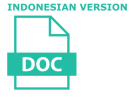Semiotic Analysis of Kokuji Formation
Stanislaus Joshua(1*), Melinda Dirgandini(2)
(1) Universitas Kristen Maranatha
(2) Universitas Kristen Maranatha
(*) Corresponding Author
Abstract
Han characters (kanji) used in written Japanese come from China, but there are characters created separately in Japan called kokuji. This research aims to investigate the formation of kokuji according to Peirce’s semiotics and rikusho (traditional classification of Chinese characters) by Xu Shen, and one additional proposed Chinese character category—namely, the kaii-keisei class. The method used in this study is library research. Of the 87 data samples taken from Reiman (1983), shoukei characters made 0% of the total amount, shiji 2.3%, kaii 71.3%, kaii-keisei 4.6%, keisei 19.5%, kasha 2.3%, and tenchuu characters 1%. Analysis results show that the formation of kokuji follows the principles of rikusho. From a semiotic point of view, objects represented by kokuji determine their sign-vehicles. Sign-vehicles are kanji or its components with perceived relations to the object. Sign-vehicles are chosen to form a kokuji based on their ability to represent the object.
Keywords
References
Atkin, A. (2013). Peirce’s Theory of Signs. In The Stanford Encyclopedia of Philosophy (Summer). https://plato.stanford.edu/archives/sum2013/entries/peirce-semiotics/
Borriello, G. (2015). Kokuji (国字): The Japanese “National Characters”. A Case Study: The Japanese Acquatic Fauna. Journal of Foreign Language Teaching and Applied Linguistics, 2(2). https://doi.org/10.14706/JFLTAL15127
Brown, K. (Ed.). (2014). Berkshire Dictionary of Chinese Biography. Berkshire Publishing Group. https://doi.org/10.1093/acref/9780190214371.001.0001
Bryant, A. J., & Badgley, J. L. (2019). Men’s Outfits. Sengoku Daimyo. https://sengokudaimyo.com/garb/mens-outfits
Buck, J. H. (1969). Some Observations on kokuji. The Journal-Newsletter of the Association of Teachers of Japanese, 6(2), 45–49.
Electronic Dictionary Research and Development Group. (2003). JMdict/EDICT Japanese-English Electronic Dictionary Database. Electronic Dictionary Research and Development Group. http://www.edrdg.org/
Henshall, K. G. (1998). A Guide to Remembering Japanese Characters. Tuttle Publishing.
Iwabuchi, T. (1989). 日本語文法用語辞典 (Nihongo Bunpou Yougo Jiten). Sanseido.
Lewis, M. E. (1999). Writing and Authority in Early China. State University of New York Press.
Machida, M., Yamada, O., & Gomi, K. (2008). Genomics of Aspergillus oryzae: Learning from the History of Koji Mold and Exploration of Its Future. DNA Research, 15(4). https://doi.org/doi:10.1093/dnares/dsn020
Matsumura, A. (2006). 大辞林 (Daijirin) (3rd ed.). Sanseido.
Merriam-Webster. (1960). Peirce, Benjamin: Charles Sanders. In Webster’s Biographical Dictionary.
Nihon Doubutsu Gakkai. (1897). Arctoscopus japonicus. Annotationes Zoologicae Japonenses, 1.
Nomura, M., & Koike, S. (1992). 日本語事典 (Nihongo Jiten). Tokyodo.
Peirce, C. S. (1998). The Essential Peirce (Peirce edi). Indiana University Press.
Qiu, X. (2000). Chinese Writing. Birdtrack Press.
Reiman, E. O. (1983). The status of Kokuji: Usage of ideographs unique to Japan. In Paper in Linguistics (Vol. 16, Issues 1–2). https://doi.org/10.1080/08351818309370586
Seeley, C. (1991). A History of Writing in Japan. E. J. Brill.
Sugimoto, T., & Iwabuchi, T. (1998). 日本語学辞典 (Nihongogaku Jiten). Oufuu.
Yamaguchi, A., Wada, T., & Ikeda, K. (2013). 旺文社国語辞典 第十一版 (Oubunsha Kokugo Jiten) (11th ed.). Obunsha. https://www.obunsha.co.jp/product/detail/077721
Article Metrics
Refbacks
- There are currently no refbacks.
Copyright (c) 2022 The Author(s)

This work is licensed under a Creative Commons Attribution-ShareAlike 4.0 International License.
_______________________________________________________________________________________________________________
JLA (Jurnal Lingua Applicata) with online ISSN 2598-0556 and print ISSN 2597-6117 is published by Departemen Bahasa, Seni dan Manajemen Budaya (DBSMB), Vocational College of Universitas Gadjah Mada. The content of this website is licensed under a Creative Commons Attribution-ShareAlike 4.0 International License. Built on the Public Knowledge Project's OJS 2.4.8.1. View website statistics.







